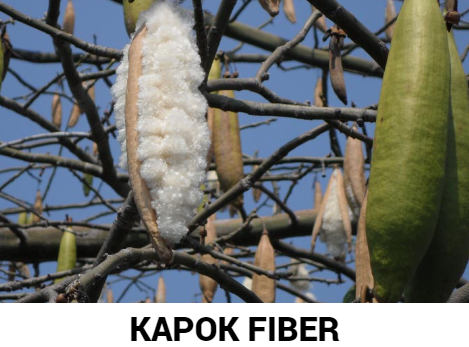No products in the cart.
News
Kapok fibers now used in biodegradable, all-natural clothing
Kapok is a fiber you may have never heard of, yet it’s commonly used in many products. And now, at least one company has figured out how to turn it into clothing. This renewable and sustainable natural material has a list of useful characteristics and causes no harm during harvest.
What is Kapok fiber?
Kapok fiber comes from the Kapok tree, which is found throughout tropical regions. You may see it referred to as Java cotton, ceiba, silk cotton or Java kapok. The fiber is pulled from the flowers, which appear as large fluff-filled pods when the tree is in bloom. The fiber is then pulled from the pod while it’s still on the tree or after it naturally falls to the ground.

Kapok isn’t a new fiber. In fact, all parts of the tree have been used for generations. Although the wood doesn’t make a strong building material, it is used to make paper and historically Kapok logs have been carved into canoes.
In modern years, the fiber has commonly been sourced as a natural stuffing for pillows, bedding and upholstery. If you have a down feather alternative in your home, it may be made from Kapok fibers. During harvest, the large pods are forced open to retrieve the seed and fiber. The materials are then sifted to remove the seeds, leaving the light, soft Kapok fibers. At that point, the seeds can be processed to obtain oil for making soap. The residue is used for fertilizer and cattle food.
The lightweight Kapok fiber dries quickly and is moisture resistant due to the natural wax coating, making it a quality material for pillows and bedding. It’s also commonly used as a soundproofing and insulation material and is an excellent choice for life jackets with a natural buoyancy that’s higher than cork.
How is it used?
Kapok fiber is often found in bedding labeled as hypoallergenic and can be part of an allergen-free bedroom. As a natural fiber, Kapok is an excellent alternative to petroleum-based materials typically used in pillows, such as polyester and foam. Plus it’s biodegradable and washable. However, kapok is flammable, which limits some of its functionality.
The airy makeup of Kapok means pillows can compress or can be stuffed for a fuller feel. The fiber is easily found from many vendors on the internet so pillows with a zipper can be added to for a longer life.
Because kapok fiber is light, weighing one-eighth as much as cotton, it’s now being developed into a wearable material. Tentree, a sustainably-minded clothing company, has recently released a line of kapok-based clothing. It’s a relatively new innovation and the weaving process is delicate and precise. The addition of kapok to clothing means the addition of insulative qualities greater than wool in a lightweight package.
Since kapok floss is fragile, it can’t be spun into fiber unless it’s blended with a more durable plant product. Therefore, the Tentree kapok lineup is made with a combination of kapok and organic cotton, including the Kapok Colville shirt. That means, at the end of its useful life, the customer can remove the buttons and feel confident about the shirts biodegrading in the landfill or the backyard. Blending kapok with cotton significantly reduces the amount of water used during the growing of the plants and production. “Producing four T-shirts with a kapok-cotton blend can save 3000 liters of water,” Tentree reports.
In alignment with the Tentree mission, kapok makes the select list of responsibly-sourced materials the company relies on. Tentree plants ten trees for each purchase of all products and is currently investing in the planting of kapok trees to build up supply in the hopes of expanding its kapok clothing product line in the future.
The supply chain
As a naturally abundant and prolific tree, the kapok offers a uniqueness to the supply chain. The trees can grow up to 13 feet per year in full sun and top out at an impressive 164 feet in height. It has an interesting production cycle that begins by dropping its foliage after the rainy season. It then blooms during the dry season. Since the tree is leafless during this time, it provides a readily available food source for bats, birds, bees and other pollinators.
In fact, the kapok tree is an essential part of the animal habitat as it offers shelter from the hot sun for insects, birds, amphibians and monkeys. It also offers a high perch for sun-seeking, canopy-dwelling species throughout the rainforest and other tropical locations.
As if to cater to the bats, the kapok flowers open at night, although only select flowers open each night, taking turns through a cycle of opening and closing over the two or three weeks the tree is in bloom.
Interestingly, kapoks don’t bloom every year. In fact, they can go five to ten years without producing a bloom. When they do, though, they go wild with up to 4,000 pods per tree.
Natural kapok fiber is being sell in Safimex Alibaba’s website with good price. If you are interested in this product, please click at: https://www.alibaba.com/product-detail/KAPOK-FIBER-FROM-VIETNAM_62008873008.html?spm=a2747.manage.0.0.7bd62c3cfp37gv or contact us at info@safimex.com to get more details
Source: In Habitat
SAFIMEX JOINT STOCK COMPANY
Head Office: 216/20a Duong Ba Trac Street, Ward 2, District 8, Hochiminh City, Vietnam.
Tel: (+84)-(28)-3636 2388 | (+84)-(28)-3636 2399 | Website: https://safimex.com/
